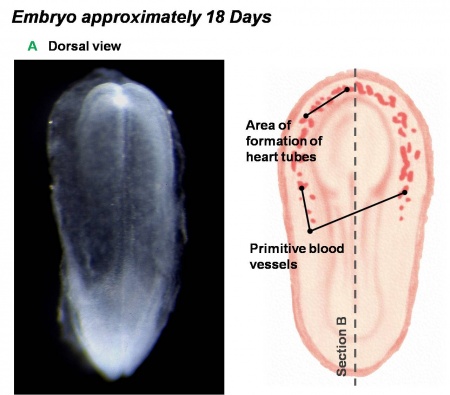Talk:Intermediate - Primordial Heart Tube
Flash Version
<Flowplayer height="564" width="720" autoplay="false">Heart folding 003.flv</Flowplayer>
--Phoebe Norville 10:28, 22 September 2009 (EST) Content added (not formatted):
The heart primordium arises predominantly from splanchnic mesoderm in the cardiogenic region of the trilaminar embryo. The cardiogenic region can be thought of as bilateral fields that merge cranially to form a horseshoe shaped field. During the third week of development (approximately day 18), angioblastic cords develop in this cardiogenic mesoderm and canalise to form bilateral heart tubes.
File:HeartILP draft HeartTubeLateral.jpg Lateral view of 18 day embryo |
Lateral folding of the embryo brings the heart tubes into the ventral midline allowing them to fuse to form a single primordial heart tube. Fusion of the heart tubes begins cranially and extends caudally and is facilitated by apoptosis. The animation below shows a cross section of the embryo, the development of the endocardial heart tubes as well as their migration and fusion in the midline.
File:HeartILP draft brightfieldtubefusion.jpg Brightfield images showing fusion of the heart tubes and the earliest appearance of segments of the fused heart tube |
After fusion constrictions and dilations appear in the heart tube forming the following divisions:
- Truncus arteriosus
- Bulbus cordis
- Primordial ventricle
- Primordial atrium
- Sinus venosus
Note that by the end of the fourth week (day 22), coordinated contractions of the heart tube are present and push blood cranially from the sinus venosus. In the previous animation, you saw that the dorsal aortae developed concurrently with the endocardial heart tubes and form a cranial connection with the endocardial heart tubes prior to folding. As the embryo folds the cranial ends of the dorsal aortae are pulled ventrally until they form a dorsoventral loop, the first aortic arch arteries. The embryonic vascular system is discussed in further detail here.
Heart Layers
Myocardium: forms from splanchnic mesoderm surrounding the pericardial coelom. Additional myocardial cells are added to the outflow tract during heart looping.
Cardiac Jelly: gelatinous connective tissue separating the myocardium and heart tube endothelium.
Endocardium: forms from the endothelium of the heart tube.
Epicardium: develops from mesothelial cells arising from the sinus venosus which spread cranially over the myocardium.

